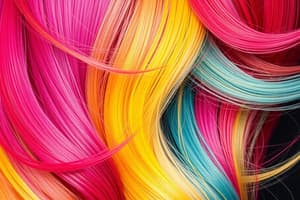Podcast
Questions and Answers
What does the level system measure in hair color?
What does the level system measure in hair color?
- The variety of hair textures
- The duration of hair color treatment
- The strength of hair strands
- The lightness or darkness of hair color (correct)
Which number represents the lightest hair color in the level system?
Which number represents the lightest hair color in the level system?
- 10 (correct)
- 5
- 8
- 1
How does saturation affect hair color?
How does saturation affect hair color?
- It influences the texture of the hair.
- It determines the length of the hair.
- It affects the strength of the color. (correct)
- It changes the thickness of the hair strands.
What is the role of base colors in artificial haircolor?
What is the role of base colors in artificial haircolor?
Which base color helps minimize orange tones in hair?
Which base color helps minimize orange tones in hair?
What factor does NOT determine haircoloring results?
What factor does NOT determine haircoloring results?
What tool is useful for identifying the natural level of a client's hair?
What tool is useful for identifying the natural level of a client's hair?
Which statement is true regarding the color level system?
Which statement is true regarding the color level system?
Flashcards are hidden until you start studying
Study Notes
The Level System
- Color levels range from 1 (darkest black) to 10 (lightest blond).
- Level breakdown:
-
- Pale yellow
-
- Yellow
-
- Yellow/gold
-
- Gold
-
- Orange/gold
-
- Orange
-
- Red/orange
-
- Red
-
- Red brown
-
- Dark red/brown
-
- Color level names may differ among manufacturers, serving as a guide for identifying lightness and darkness in hair colors.
- Essential for determining natural hair color levels and for the formulation, matching, and correcting of colors.
Saturation
- Saturation refers to the intensity and concentration of pigment in a color.
- A highly saturated color is vivid, while less saturation results in a muted appearance.
- More saturated products produce a more dramatic color change in hair.
Base Color
- Artificial hair colors are derived from primary and secondary colors to form base colors, which influence the final color outcome.
- Examples of base colors:
- Violet base: Produces cool results, minimizes yellow tones.
- Blue base: Reduces orange tones.
- Red-orange base: Creates warm and bright tones.
- Neutral base: Softens and balances other colors.
Identifying Natural Level and Tone
- Results depend on the combination of the client's natural hair color and the chosen artificial hair color product.
- Identifying natural level and tone is crucial for product selection and predicting final results.
- Utilization of manufacturer’s swatch or color ring helps match the client's hair color accurately.
- Manufacturer's swatches are a practical tool in the identification process.
Additional Notes
- Importance of protein condition for strengthening hair during the coloring process.
Studying That Suits You
Use AI to generate personalized quizzes and flashcards to suit your learning preferences.





